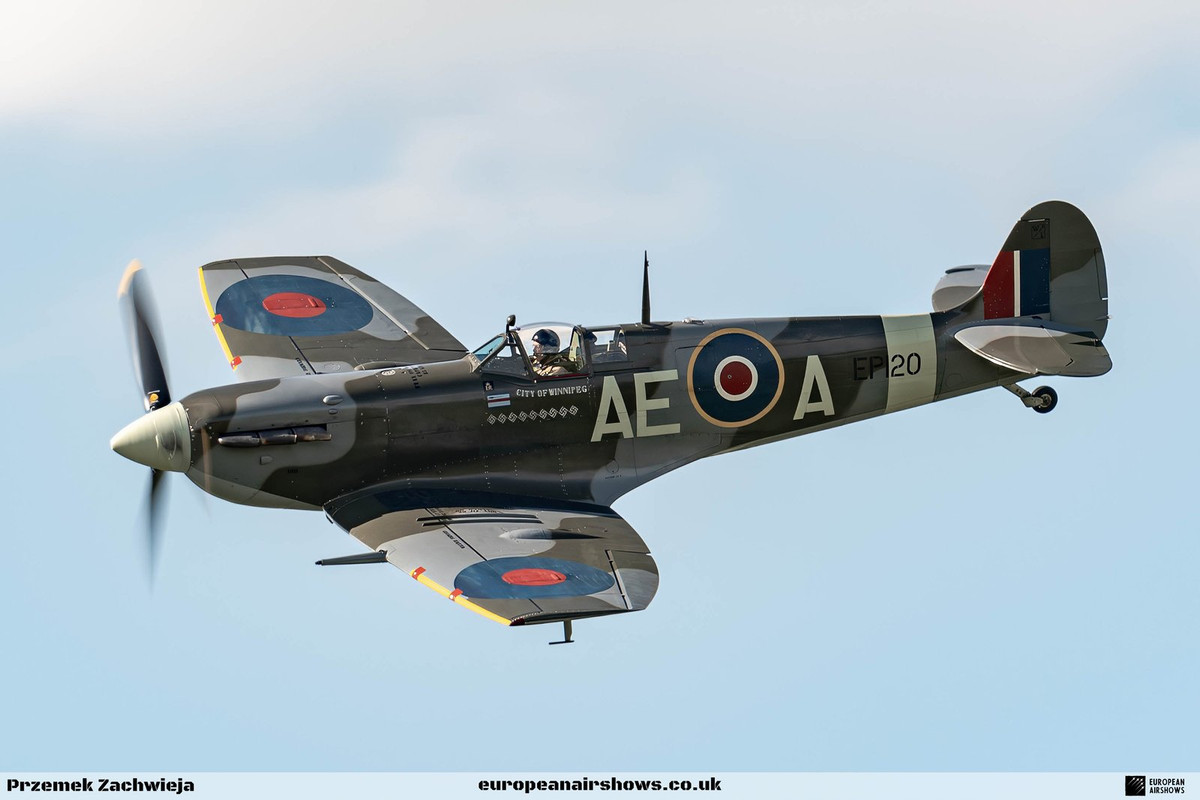
Supermarine Spitfire Mk.Vb G-LFVB
About the Spitfire
The Supermarine Spitfire first took to the air in the mid‑1930s and quickly became an icon of British aviation. Designed by Reginald Mitchell for the Royal Air Force, its distinctive elliptical wing and innovative stressed‑skin construction enabled exceptional speed and maneuverability. From early prototypes to successive “marks” that introduced improved armament, stronger structures, and more powerful Rolls‑Royce Merlin engines (and later Griffon engines), the Spitfire was continuously refined to meet the changing demands of aerial combat during World War II. Its elegant design and high performance made it a symbol of determination and hope during Britain’s darkest hours.
Throughout its operational history, the Spitfire evolved from a sleek, single‑seat interceptor into a multifaceted workhorse. Early versions faced significant production challenges with rapid modifications—ranging from upgrades in cockpit design to re‑armament changes driven by combat experience. The aircraft played a decisive role in the Battle of Britain and later proved adaptable as a fighter‑bomber, a high‑altitude interceptor, and even as a carrier‑based fighter (in the Seafire variant). By the end of the war, more than 20,000 Spitfires of various marks had been built, a testament to its versatility and the industry-wide efforts that supported its production.
Even as World War II drew to a close, the Spitfire’s development continued with further modifications to improve high‑altitude performance, extend range with increased fuel capacity, and enhance pilot visibility. The transition from Merlin to Griffon engines ushered in a new era of performance that allowed the aircraft to remain competitive against evolving enemy designs. Long celebrated after the war as a masterpiece of aeronautical engineering, the Spitfire is now an enduring symbol of British ingenuity, frequently appearing in museums and airshows, where it continues to captivate aviation enthusiasts around the world.
Specifications
Crew
1
Length
29 ft 11 in (9.11 m)
Wingspan
36 ft 10 in (11.23 m)
Height
11 ft 5 in (3.6 m)
Max Speed
370 mph (597 km/h, 322 kn)
Range
248 mi (400 km, 215 nmi)
Service Ceiling
35,000 ft (10,668 m)
Rate of climb
3,877 ft/min (19.7 m/s)
Mk Vb Variant
The Mk Vb was a major production version of the Supermarine Spitfire that played a critical role in early- to mid‐World War II before more advanced marks appeared. Evolving directly from earlier Mk I and Mk II models, the Mk Vb incorporated a series of modifications – applied both to improve its performance and to address combat feedback – that would make it one of the most numerous and versatile variants of the Spitfire family.
During late 1940 and early 1941, as the operational environment in Europe became increasingly challenging, the Royal Air Force sought a fighter that could combine high performance with robust adaptability. The Mk Vb was produced by converting some Mk Ib airframes and then built from the production line with a new set of refinements. It was powered by the Rolls‐Royce Merlin 45 engine, which delivered approximately 1,440 horsepower, while maintaining the excellent handling characteristics that had become a Spitfire signature.
One of the most notable improvements on the Mk Vb was the incorporation of a new “B” wing configuration in many models. This design – sometimes described as a “universal” or “C‑type” wing later on – modified the armament packaging. In the Mk Vb, the inner machine gun bays were designed so that one pair of Browning .303 machine guns could be replaced by a pair of 20 mm Hispano cannons. This change increased striking power without compromising maneuverability. Other visible changes included the replacement of the early round-section exhaust stacks with a fishtail design; these fins not only helped to slightly boost thrust but also offered a distinctive silhouette that set the Mk Vb apart from its predecessors.
Field experience during the early war – and the increasing threat posed by German fighters like the Messerschmitt Bf 109 and later the Focke-Wulf Fw 190 – led to incremental improvements. Early Mk Vb versions sometimes experienced problems with oil cooling, and these were rectified by fitting a larger oil cooler on the port wing, recognizable by its deeper, circular housing. The Mk Vb was also subject to modifications in cockpit features and aileron coverings; metal ailerons gradually replaced fabric-covered surfaces, providing more reliable control at the higher speeds that the new engine configuration made possible.
The versatility of the Mk Vb was further demonstrated by its “tropicalised” version. In response to the harsh desert conditions faced by RAF units in North Africa and the Middle East, the Vb trop was fitted with a larger, streamlined air filter – originally the bulky Vokes type and later reworked locally into a more aerodynamic Aboukir design – to protect the engine from dust and sand. Additional survival gear and specific desert camouflage schemes were applied, ensuring the aircraft could operate reliably in extreme climates.
Entering service in early 1941, the Mk Vb quickly became the workhorse for many RAF fighter squadrons. Its blend of speed, agility, and improved firepower made it well suited to engaging both enemy fighters and bombers. It served not only over the home front during critical stages of the air battles over Britain but also, through its tropicalised version, in desert theaters. The reliability and adaptability of the Mk Vb provided the RAF with an essential stop-gap measure while the more complex and higher‑performance Mk IX was being brought into production.
Did You Know?
- The destruction of Supermarine’s Itchen and Woolston factories by enemy bombing led to production being shifted to numerous “shadow factories”—with Castle Bromwich becoming the main hub for Spitfire manufacturing.
- Early Spitfires were famous for their elegant, elliptical wing design, chosen not only for its low induced drag but also for its aesthetic appeal—a design feature that helped to capture the public’s imagination.
- The Spitfire Mk IX was actually developed as a “stopgap” measure in response to the Focke‐Wulf Fw 190 threat and was produced from converted Mk Vc airframes before later high‐altitude models appeared.
- Some Spitfire variants were adapted for photo reconnaissance. For example, the PR Mk XIX became the definitive reconnaissance version with increased fuel capacity and specialized camera installations.
- Engine changes sometimes required more than simply swapping powerplants—the installation of the Griffon engine, for instance, necessitated modifications to the cowling, tail, and undercarriage to cope with its different thrust line and increased weight.
Test Your Knowledge
1. Which factory became the main production site for Spitfires after the original Itchen and Woolston plants were destroyed?
Spitfire Mk.Vb G-LFVB
EP120 is an iconic Mk.V Spitfire with a rich and varied history that spans from the early days of World War II through to modern aviation heritage. With an impressive record of seven confirmed kills, EP120 is celebrated not only for its combat achievements but also for its extensive service in several roles before becoming a beloved part of The Fighter Collection.
Built at the Castle Bromwich factory, EP120 is believed to have taken to the skies on a test flight piloted by none other than the famed Alex Henshaw. The aircraft was accepted into RAF service in May 1942 with 45 MU at Kinloss in Scotland. Soon after, in June 1942, EP120 was assigned to No. 501 Squadron, where under the leadership of Squadron Leader Geoffrey Northcott, it racked up six of its confirmed enemy kills.
A notable incident during her wartime service was a ground collision that necessitated repairs at Castle Bromwich. Once fixed, EP120 was transferred to No. 19 Squadron in Cornwall. The aircraft’s journey continued in April 1944 when she joined No. 402 “City of Winnipeg” Squadron of the Royal Canadian Air Force, marked with the code AE-A – the same vibrant colours she proudly carries to this day. After a brief stint with No. 33 MU at Lyneham in June 1944, EP120 moved to No. 53 Operational Training Unit (OTU) at Kirton in Lindsey.
Following her active combat and training roles, EP120 spent a period serving as a ground instructional airframe. Her enduring legacy was further cemented when she took on the role of a gate guardian at several RAF stations for many years. In 1967, EP120 enjoyed a moment in the spotlight as a static aircraft in the film “Battle of Britain.” After filming, she returned to her gate guard duties at RAF Wattisham until 1989 when she, along with several other guardian Spitfires, was moved to St. Athan.
Stored at St. Athan for several years, EP120’s storied career took a turn for the better in 1993 when she joined the fleet of The Fighter Collection. After undergoing a detailed and full restoration, EP120 re-entered the skies in September 1995. Since then, she has been a crowd-pleaser at airshows, captivating both aviation enthusiasts and pilots alike with her historical charm and formidable legacy.







